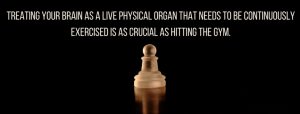This article is based on multiple researches and studies conducted by neuroscientists who have explored the Brain and its underlying impact on Learning.
Our brain is an interesting organ. It begins to mature even before we are born. Biologically it acts as the management tool of our human body. It guides our sensory responses, houses our grey matter and centrally controls the functioning of the other organs. The brain is like the seat of the mind, almost the physical basis or source of the mind. Every day our brain changes through experience, as we form memories, learn facts, build associations, or even travel to new places and eat new food.
Neuroscientists have been exploring the impact of the brain and responses to evolve the understanding and effectiveness of education and learning of children and adults.
Young brains are capable of forming many new synapses, and they are consequently better at learning new things. That is why we acquire vital skills – walking, talking, hearing and seeing – early on in life. The adult brain stabilises the synapses so that we can use what we have learned in childhood for the rest of our lives.
Let’s consider a few facts that have been researched to look at the impact of our brain on learning that could provide insights
- Brains do not mature at the same rate in each individual. This is critical to understanding that rate of maturation of the brain influences learning readiness.
- Again all brain functions do not mature at the same rate which implies that a key strength for someone could be an area of weakness for another. An individual could be cognitively advanced but show emotional immaturity.
The above two facts establish that there are developmental differences in people and the ability and pace of learning differs. It is thus critical for parents and teachers to ensure education of children is holistic and enabling different brain functions to develop. It is important, that a variety of “ideas, experiences, skills and materials” are used as a diverse mode of instruction to explore and learn using “several senses or multiple skills at the same time”.
Brain and adult learning
A study on training the aged brain tries to deconstruct the impact of brain ageing that impacts adult learning. How many of us get distracted easily, have wandering minds and begin day dreaming when we should be focusing and listening? These are natural phenomena that start occurring as brain ages.
The theory that as we grow older our brain cells are lost has been debunked but it is a fact that information that gets collected in our heads over time gets pushed in the folds of neurons as we age. We need to think harder to remember. However on the positive side is that as we grow older, our brain gets better at recognizing the central idea, the big picture and has the ability to draw patterns and associations which enables an adult mind to take better and faster decisions compared to younger people.
To quote, ‘Stretching’ is exactly what scientists say best keeps a brain in tune: getting out of the comfort zone to push and nourish the brain. Do anything from learning a foreign language to taking a different route to work.

Let us look at a few ways learning can be made interesting and stimulate the brain or adult minds
Can having ‘fun’ impact our neural responses and shift behaviors? Neuroscience research tells us that when fun stops, often learning stops too. There are many benefits of joy in the classroom.
When students are engaged and motivated and feel minimal stress, information flows freely through the affective filter in the amygdala and they achieve higher levels of cognition, make connections, and experience “aha” moments. Such learning comes not from quiet classrooms and directed lectures, but from classrooms with an atmosphere of exuberant discovery (Kohn, 2004).
Cognitive psychology studies provide clinical evidence that stress, boredom, confusion, low motivation, and anxiety can individually, and more profoundly in combination, interfere with learning (Christianson, 1992).
Pleasurable associations linked with learning are thus more likely to release more Dopamine
It is also released when a person gambles and wins (or loses), takes certain addictive drugs like cocaine, or just engages in a new exciting adventure. For many of us, learning about new things is an adventure and very rewarding, and dopamine levels increase in the brain to help us retain that new information. But for some learners, if dopamine levels are low, the new information literally goes in and out of the brain and is lost.
Rewards typically serve as reinforcers. Carefully used, reinforcement is one of the greatest memory enhancers in the brain because it is so powerful at increasing dopamine. Asking questions, guiding towards right answers, rewarding effort builds the reinforcement cycle and allows for greater retention in memory. When we are teaching, the use of questioning techniques to provoke reflections, facilitating or guiding the student towards answers and most importantly complimenting them after for success is how reinforcement works in action.
Fun based challenging activities can be used to create an emotional and creative environment that releases dopamine. Both positive and negative social emotional experiences change the brain. Creating an environment that builds motivational pathways, where anxiety is low while providing enough challenge and novelty for suitable brain stimulation is an important role for the teacher and facilitator.
Researchers state that teaching new facts should not be the focus of adult education. Instead, continued brain development and a richer form of learning may require assimilating perspectives, reading multiple points of views, inferring and “prying open brain networks” by reflecting on how what was learned has changed the individual’s view of the world. This is also referred to as “disorienting dilemma,” or something that “helps you critically reflect on the assumptions you’ve acquired.”
To summarize, effective learning that stimulates the adult brain requires –
- An ambience which is stress free and joyful but providing sufficient challenge to learn something new
- Rewarding that leads to greater retention and shift in behaviors
- Teaching that involves building on multiple points of view and reflecting on assumptions acquired

